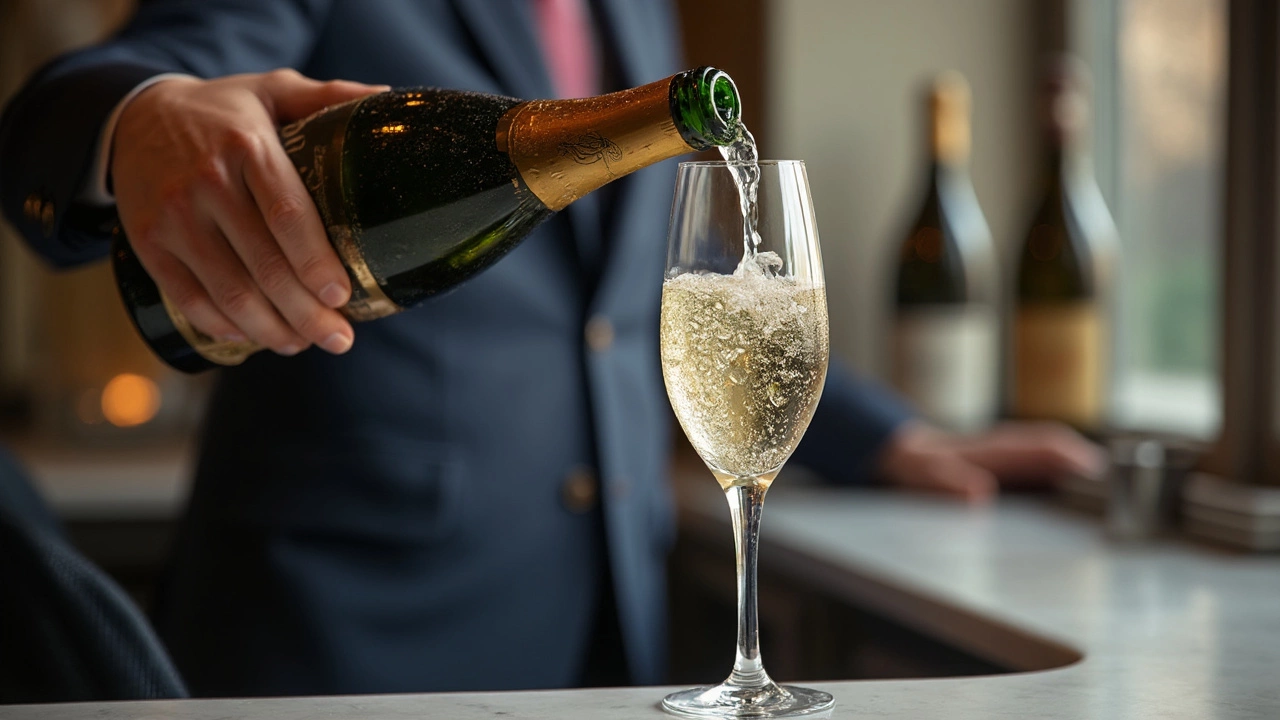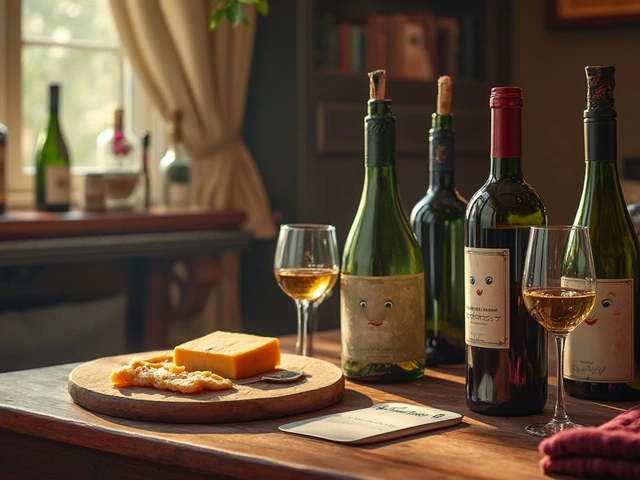Ever wondered why fancy dinners serve Champagne in those skinny glasses, or what’s up with all the swirling and sniffing? Champagne etiquette isn’t just for wine snobs or high society parties—it’s about making the most of those celebratory bubbles without breaking a sweat (or accidentally launching a cork at your boss).
First things first: always chill your bottle. Cold Champagne, ideally between 45–50°F, preserves the bubbles and brings out the flavor. That’s not just fancy talk; a warm bottle means more foam, less control, and way less enjoyment.
When it comes to opening, keep it quiet. Forget what you see in movies—the dramatic “pop” wastes bubbles and can get messy. Hold the cork and twist the bottle slowly, so it sighs open. If you’re worried about spraying the room or yourself, practice with a cheaper bottle first.
Picking the right glass is key, too. While coupes look retro and flutes keep the fizz, many Champagne pros now swear by tulip-shaped glasses. They let you enjoy the aroma without losing all those precious bubbles. If you’ve only got flutes, no worries—they’re still way better than a wine glass for keeping things fizzy.
- Picking the Right Glass
- Serving and Pouring Champagne
- Toasting Without Stress
- Sniff, Sip, and Savor: Tasting Tips
- Dos and Don'ts at a Tasting
Picking the Right Glass
If you thought any old glass would do for Champagne, think again. The glass really matters when you want to enjoy the taste and bubbles the right way. Each shape does something different for aroma, fizz, and the whole experience.
Let’s look at the three main types:
- Flute: Tall and skinny, this is probably what most people picture for Champagne. The long shape helps bubbles last longer and travel up in neat streams. That’s not just for looks — it actually keeps the taste fresh, and you see more of those lively bubbles.
- Coupe: Think “Great Gatsby” parties and those shallow, wide glasses. They’re stylish and make for great photos, but they let the fizz escape way too fast. You’ll lose aroma and get a flat drink quick.
- Tulip: This shape is the real winner if you want to do things right. It looks like a wine glass but has a slight curve inward at the rim. The tulip holds in the fizz and aromas better than a regular flute. It lets you swirl to open up the flavor (just don’t overdo it or you’ll lose bubbles).
Here’s a quick table that spells it out:
| Glass Type | Bubble Retention | Aroma | Best For |
|---|---|---|---|
| Flute | Excellent | Limited | Keeping fizz at parties |
| Coupe | Poor | Very low | Photos, vintage vibes |
| Tulip | Great | Excellent | Serious tastings |
If you care about champagne etiquette, the tulip glass has become the go-to choice for sommeliers and top Champagne houses. Flutes are a safe bet for most gatherings; they’re foolproof if you want to keep things bubbly, especially at bigger events. Save the coupe for dessert cocktails or when you want to feel like you’re in a 1920s movie — just don’t expect your drink to last long.
One extra tip: Always hold your glass by the stem, not the bowl. That keeps your hand from warming up the Champagne. No one wants lukewarm bubbles.
Serving and Pouring Champagne
You don’t need a tux or white gloves to serve Champagne the right way, but a few solid tips make a big difference. Let’s start with temperature. As mentioned earlier, keep the bottle chilled between 45–50°F (7–10°C). Warmer than that, and you’ll lose fizz fast. Don’t toss it in the freezer though—rapid chilling can dull the flavor, plus nobody wants an exploding bottle. Sitting the bottle in an ice bucket with equal parts ice and water for about 20 minutes does the trick.
Now for the grand moment: pouring. To avoid an avalanche of bubbles and wasted wine, tilt the glass at a 45-degree angle and pour the Champagne slowly along the side. Once the glass is half-full (that’s the sweet spot), set the bottle down. This way, you preserve the bubbles and avoid instant foam-ups.
- Always pour a little at first, let the bubbles settle, then top up to half-full.
- Never fill the glass to the rim—Champagne needs space to breathe. This also leaves room for those aromas to open up.
- If you’re serving a crowd, serve ladies first, then gents. Old-school but still the standard at formal tastings.
Don’t forget about the label. Pros always pour with the label facing the guest. It looks sharp and lets everyone know what they’re sipping.
| Step | What to Do |
|---|---|
| Chill | Ice bucket, 20 mins, 45–50°F |
| Open | Twist bottle, keep cork quiet |
| Glass angle | 45 degrees, pour slowly |
| Fill level | Half-full max |
| Label | Face label towards guest |
One last tip: When you’re pouring, hold the base of the bottle, not the neck. It’s easier to control and just looks more polished. And if you want to really nail champagne etiquette, keep a napkin handy to wipe drips between pours—no one likes sticky bottles.

Toasting Without Stress
Toasting with Champagne shouldn't feel like walking a tightrope. The basic move? Stand up if it’s a formal moment, keep your glass at chest level, and make eye contact with the folks around you—no awkward stares at the ceiling. Don’t clink too hard. Champagne glasses are thin, and nobody wants to start a toast with shattered glass.
There’s no rule that says you have to say something long-winded. A short, genuine remark works just fine. "Cheers" covers you in any crowd. If you’re in France, “Santé” is standard. At a big event, the host or key guest usually leads the champagne etiquette—just follow their lead. And if you're the one making the toast, keep it light and positive. Humor is fine, but nothing that might embarrass anyone.
Worried about when to sip? Wait until the toast is finished, then take a real drink instead of just pretending. If you’re skipping alcohol, you can still join the toast—just raise your glass, even if it’s filled with something non-alcoholic.
- Hold your glass by the stem, not the bowl. It keeps your drink cold and looks more polished.
- Don’t pour yourself Champagne before the host signals it’s time. Let everyone be served before you raise your glass.
- During group celebrations, a simple toast can kick things off and help everyone relax.
Check out some quick-fire basics for keeping your toast on track:
| Tip | Why it matters |
|---|---|
| Keep it short | Nobody likes a long speech before a drink |
| Look people in the eye | Shows respect and confidence |
| No aggressive clinking | Prevents spills and broken glass |
| Smile | People remember the vibe, not the words |
Bottom line: Toasting isn’t about being perfect. It’s about joining in, sharing the moment, and having fun with the bubbly. That’s something everyone can get behind.
Sniff, Sip, and Savor: Tasting Tips
If you really want to appreciate Champagne, don’t just gulp it—there’s a simple ritual pros swear by, and anyone can do it. The whole sniff-sip-savor method helps you catch everything the wine maker worked so hard for.
Let’s keep it practical. Start by holding the glass by the stem, not the bowl. Your hand’s warmth messes with the chill and flavor. Next up, take a good look at those bubbles. Fine, steady streams mean quality—cheap ones often fizzle out quick.
- Sniff: Give the glass a gentle swirl (no shaking—this isn’t a protein shake). Bring it close and take a couple of short sniffs. You might pick up hints of apple, toast, citrus, or almond. Cork taint or musty smells? Pass on sipping; that’s a bad bottle.
- Sip: Take a small sip and let it roll across your tongue. Notice if it’s dry, sweet, or somewhere in the middle (look for the label: "Brut" is the most common and driest). Good Champagne feels creamy, with tingling bubbles that last.
- Savor: After you swallow, see what flavors stick around. Top bottles leave a clean, crisp finish with maybe a hit of fruit or biscuit. Weak stuff? The taste fades fast or just tastes dull.
Some people check color, but most real-deal tastings focus on smell and mouthfeel. If you’re trying several bottles, rinse with water (and keep snacks like plain crackers handy to clean your palate).
| Step | What You’re Looking For |
|---|---|
| Sniff | Fresh aromas (apple, toast, almond), no musty smells |
| Sip | Creamy texture, lively bubbles, balanced sweetness/acidity |
| Savor | Long finish, lingering flavors, no bitterness |
Last thing—a useful fact: the champagne etiquette experts at the Comité Champagne say even top bottles only need a half-glass pour per tasting. This keeps it cool, lets the bubbles last, and means you can try more varieties without getting wobbly.

Dos and Don'ts at a Tasting
Even if you’re not a Champagne connoisseur, you can blend in like one by sticking to a few practical rules. It’s not about being fancy—it’s about enjoying the bubbles and not getting side-eyes from across the room.
- Do hold your glass by the stem. This keeps the Champagne cold. Wrapping your hand around the bowl warms it up fast, and nobody wants flat, warm bubbles.
- Do take your time. Sip, don’t gulp. This lets you actually taste the layers in the Champagne, from citrusy notes to hints of brioche.
- Do rinse your glass with a splash of Champagne (not water) if you’re switching from another drink. Water lingers and can mess with the flavor and fizz.
- Do ask questions. Most hosts love sharing details, like which village the Pinot Noir comes from or why one bottle smells like apples. Curiosity shows interest, not ignorance.
- Do remember to pace yourself. Champagne is easy to drink but surprisingly strong—so alternate with water, especially if you want to remember what you tasted.
- Don’t fill your glass to the top. Stick to about one-third full. This is legit etiquette and lets the aromas develop so you actually get the most out of the experience.
- Don’t swirl Champagne the way you see with red wine. That breaks up the bubbles too quickly. Just a gentle tilt is enough if you’re checking out the color.
- Don’t cover up the flavor by eating strong foods between sips (like onion dip or spicy wings). Stick with neutral palate cleansers—think plain crackers, mild cheeses, or even a hunk of baguette.
- Don’t make loud noises when clinking glasses. A gentle tap is fine, but hard bangs risk chipping the thin rims.
- And the biggest champagne etiquette fail? Don’t pretend to know everything. Nobody likes a show-off. Stay humble, enjoy the bubbles, and you’ll fit right in.
Bottom line: Treat the Champagne (and everyone at the tasting) with respect, and the experience gets a lot better for everyone.


